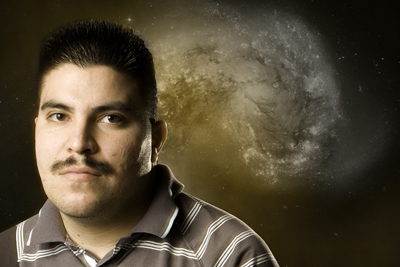
When New Mexico Highlands University math instructor Carlos Martinez was star gazing as a child from his home in Sapello, he never dreamed that one day he would discover an asteroid and get to officially name it the Sapello asteroid. The night sky in Sapello, 12 miles north of Las Vegas, is known for the brilliance of its stars. Martinez, a fourth-generation Sapello resident, said he always found the stars mysterious and beautiful. Now, his asteroid discovery puts Sapello on the astronomical map. It started when Martinez, who earned his bachelor’s degree with a double math/physics major from Highlands, was working as an assistant on an asteroid project at NMHU with professor Bill Ryan. Later, while in graduate school at the University of New Mexico, Martinez and Ryan, now a New Mexico Tech professor, discovered the Sapello asteroid together. Both are named on official International Astronomical Union documents for the asteroid. Martinez credits Ryan for sparking his interest in physics and encouraging him to pursue his master’s degree. Martinez’ interest in physics evolved into astronomy, a branch of physics that studies celestial bodies. Martinez, who has a knack for explaining science in everyday language, said that asteroids look like stars whether you’re looking through research-grade telescope or the naked eye. The main difference is that asteroids move continuously while stars don’t. NASA defines asteroids as rocky fragments left over from the formation of the solar system 4.6 billion years ago. Asteroids orbit our sun and are too small to be called planets. Most asteroids are gathered in the main asteroid belt in between the orbits of Mars and Jupiter. The Sapello asteroid is in this main asteroid belt.
“Usually new asteroids are discovered by robotic telescopes,” Martinez said. “We discovered the Sapello asteroid in a different way. We used a 1.8 meter research-grade telescope and an astronomy analysis software program with images in time series that detect movement. We were using a Vatican Advanced Technology Telescope on Mount Graham in Arizona studying a different asteroid when we discovered the unexpected movement of an unidentified asteroid. Knowing that you help discover something new that no one has seen before and then naming it is very cool.”
The International Astronomical Union oversees the formal scientific verification of new asteroids as well as the naming process. The Sapello asteroid became official once the IAU gave its seal of approval.
“We are very proud of Carlos and are absolutely lucky to have him come back to Highlands as a math instructor,” said David Olivas, department head of the Math, Engineering and Physics Department at Highlands. “He’s an accomplished mathematician and is willing to teach introductory as well as advanced math. His students relate well to him.”Martinez said: “I really like teaching and working with students. I try to make math relevant to their life by using interesting applied problems. For example, people listen when you illustrate a complex math concept that relates to money.”
Olivas said that Martinez’ success in discovering the Sapello asteroid shows how science comes first when making these kinds of discoveries.
“Carlos had to know the physics and math first before he could discover the Sapello asteroid,” Olivas said. “We don’t use telescopes in a random fashion.”
Olivas said he is pleased that Highlands has a 16″ telescope that students use beginning in an introductory astronomy class. He said spring semester registration for this class filled up on the first day.” Astronomy is fun,” Olivas said. “It’s great that we have a telescope at Highlands to offer this scientific learning opportunity to our students.”
